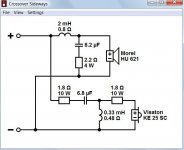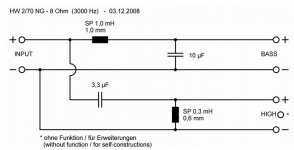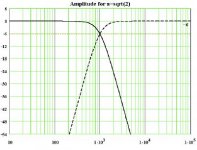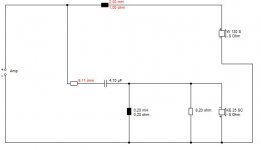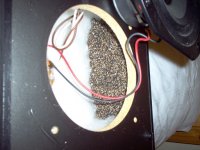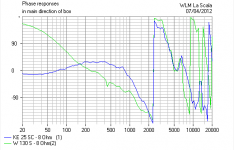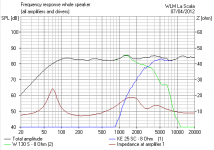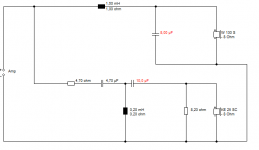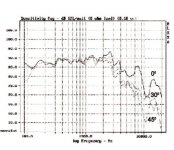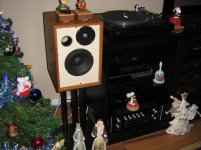midrange
with your words, it tames the impedance rise
inductors gets more effective(bigger) with lower impedance
and, gets smaller with higher impedance
the result of rising impedance is a less effective inductor
tho your 2mH is quite big
you might want a smaller zobel, to be only effective at higher frequency, in the upper midrange passband
in any case, in this kind of simple filter, the zobel have positive effect in regards of phase
but needs to be very finely adjusted to do this
with your words, it tames the impedance rise
inductors gets more effective(bigger) with lower impedance
and, gets smaller with higher impedance
the result of rising impedance is a less effective inductor
tho your 2mH is quite big
you might want a smaller zobel, to be only effective at higher frequency, in the upper midrange passband
in any case, in this kind of simple filter, the zobel have positive effect in regards of phase
but needs to be very finely adjusted to do this
Actually the inductor on the tweeter is .2mH...quite small...and the tweeter has a built in LCR network in it already...I think that's what Steve was counting on...
Yesterday though, I reversed the polarity and had really good results...tamed that midband energy...so that means the series RC network is running on the negative side of the tweeter...
In Steve's xover, the tweeter is reversed already...I'll keep it like that for this trial and report back...
I'm hoping parts will be in early next week
Yesterday though, I reversed the polarity and had really good results...tamed that midband energy...so that means the series RC network is running on the negative side of the tweeter...
In Steve's xover, the tweeter is reversed already...I'll keep it like that for this trial and report back...
I'm hoping parts will be in early next week
paralel inductor on tweeter cuts the lowest frequencies from the tweeter
in paralel its function is the opposite as to being in series
the same goes for caps
as for the tweeter 0.2mH being quite small, yes
means it cuts early
Dissi's 0.3mH looks more right, or normal
there is no standard one size fits all, ofcourse not
but with this filter some components and values are often very similar
but ofcourse always a little different
in paralel its function is the opposite as to being in series
the same goes for caps
as for the tweeter 0.2mH being quite small, yes
means it cuts early
Dissi's 0.3mH looks more right, or normal
there is no standard one size fits all, ofcourse not
but with this filter some components and values are often very similar
but ofcourse always a little different
Sideways, someone asked before but I will ask again. Is there any chance of posting your frd and impedance measurements of your drivers? If you can't do the simulation yourself, I'm sure there are others who would be happy to plug them in and give them a run.
I'm not sure if PCD was one of the sims you tried, it is great as you can see the results in real time as you change things, you need microsoft excell to run it though. Loudspeaker Design Software I personally use PCD for getting in the ball park, and then change over to speaker workshop to do optimisations.
Tony.
I'm not sure if PCD was one of the sims you tried, it is great as you can see the results in real time as you change things, you need microsoft excell to run it though. Loudspeaker Design Software I personally use PCD for getting in the ball park, and then change over to speaker workshop to do optimisations.
Tony.
K...understand now about what you are saying...that wouldn't be hard to tweak afterwards...and I think the reason it is cutting out early is because we are basically letting the Morel run it's course naturally...
Hey Tony
I do actually have PCD but I couldn't figure it out enough to work LOL!!! And they say the DEQX software is complicated...it was a walk in the park in comparison for me...must be because I'm old...I like wizards
Hey Tony
I do actually have PCD but I couldn't figure it out enough to work LOL!!! And they say the DEQX software is complicated...it was a walk in the park in comparison for me...must be because I'm old...I like wizards
there are a lot of places to put things in PCD I will admit  it's knowing which ones that are important that helps a lot. If you do your measurements on a single axis (ie not on axis with each driver, say half way between the two) then you don't have to worry about all of the offset stuff, and you just start off with a standard network. and go from there.
it's knowing which ones that are important that helps a lot. If you do your measurements on a single axis (ie not on axis with each driver, say half way between the two) then you don't have to worry about all of the offset stuff, and you just start off with a standard network. and go from there.
Tony.
Tony.
I'd like to know how Dissi arrived at that 2nd order crossover really. It could be very good, but I wonder what sort of data it was based and what considerations came into it. sideways wanted something low order initially but I thought the tweeter looked awkward on first order and overlapped with the bass badly, hence the second order treble. The bass might be good on a single coil because it has little cone breakup. 
This is all guesswork really since Morel don't make it easy. The Visaton tweeter is an unusual beast with built in LCR correction of Fs resonance, but it also has an odd frequency response when you filter it as a result. You probably wouldn't go far wrong with the generic Visaton 3kHz crossover and a bit of padding, but time will tell.
Meantime two interesting things to read. Thanks to wintermute's knowledge of Morel.
Lynn Olson on the problems with first order filters and "LGWAG" speakers:
http://www.diyaudio.com/forums/multi-way/190663-can-you-have-sparkling-treble-but-without-sibilance-2.html#post2604196
All his posts in that thread are enlightening as usual.
Secondly, the MOREL lowdown, why they are not for tightwads and why we (well, all except sreten and Zaph...LOL) like them:
LDSG - Morel recommendations
This is all guesswork really since Morel don't make it easy. The Visaton tweeter is an unusual beast with built in LCR correction of Fs resonance, but it also has an odd frequency response when you filter it as a result. You probably wouldn't go far wrong with the generic Visaton 3kHz crossover and a bit of padding, but time will tell.
Meantime two interesting things to read. Thanks to wintermute's knowledge of Morel.
Lynn Olson on the problems with first order filters and "LGWAG" speakers:
http://www.diyaudio.com/forums/multi-way/190663-can-you-have-sparkling-treble-but-without-sibilance-2.html#post2604196
All his posts in that thread are enlightening as usual.
Secondly, the MOREL lowdown, why they are not for tightwads and why we (well, all except sreten and Zaph...LOL) like them:
LDSG - Morel recommendations
Attachments
I have two independent measurements of the Morel HU 621: manufacturer data sheet and HobbyHiFi 6-2007 (german loudspeaker magazine). Both are quite similar. I'm very sorry to say, but the driver has a series of perturbations starting from 1.5 kHz and is actually better suited as woofer in a 3-way. For that reason and to get a better phase at 2.2 kHz, I did choose a 2nd order low-pass.
(ie not on axis with each driver, say half way between the two) then you don't have to worry about all of the offset stuff,
While a single axis is true, typically you measure on the tweeter axis, not in between. You would not extract phase on the single-axis measurements.
If you use individual measurements of each driver's axis, you can then extract phase and take advantage of the Power Response, off-axis sliders, and different listening axis if you like. You do have to enter offsets, but this makes the tool more versatile than a single-axis design.
Later,
Wolf
For a single axis, you would measure on the intended listening axis, whatever that may be. If you take a combined response on the same single axis, you can enter the physically-measured y-offsets, overlay the combined measured response with the PCD summed response of the other two measurements, and objectively determine the true z-offset by getting the summed response to match the measured combined response. Phase and the off-axis sliders remain useful tools with a single-axis measurement when done this way, as long as you aren't measuring from too close.
It was easy in my case as I designed an MTM, So I just measured on axis with the tweeter (which was also the listening axis) . Thanks for the correction wolf and dumprtuck  Whilst I had done measurements on my old three way, they were crude and not subjected to the rigourous simulation and comparison I did with my MTM.
Whilst I had done measurements on my old three way, they were crude and not subjected to the rigourous simulation and comparison I did with my MTM.
Tony.
Tony.
Lynn Olson on the problems with first order filters and "LGWAG" speakers:
http://www.diyaudio.com/forums/mult...eble-but-without-sibilance-2.html#post2604196
All his posts in that thread are enlightening as usual.
That thread is a goldmine
I've just been re-reading some of the posts, and the one where he mentions DCR on shunt coils on the tweeter crossover was also an eye opener. How many times have you read that you can use a small gauge (ie high dcr) coil for shunts on tweeters... bzzzz wrong. see this post for his reasoning http://www.diyaudio.com/forums/mult...eble-but-without-sibilance-2.html#post2605559 (actually mentioned first by simon in post 46)
Well worth a read of the thread. Posts 17, 37, 42, 44, 46 and 48 probably had the biggest influence on my design changes, but there were heaps of good posts in between as well.
Tony.
Ok...finally got in some parts...yeah!!!
Built the xover based on what Steve suggested...subsituting a 1.5mH on the Morel...and using a 4.7ohm resistor inline on the tweeter side...tweeter is wired as the diagram suggests...out of phase...which is supposed to put it back in phase witht he woofer I'm assuming??
Sound is really nice at the moment...it's changed a few times but I can see that with new parts...it's starting to have a more pinpoint soundstage...
Voicing and tone are very nice...nothing is exaggerated...so far LOL!!!
Bass is nice and as tight as I would want it...it still has that warm touch to it...great on jazz!!
So Steve...what is the actual xover point now of this design??
Thanks again for all your help!!
Dave
Built the xover based on what Steve suggested...subsituting a 1.5mH on the Morel...and using a 4.7ohm resistor inline on the tweeter side...tweeter is wired as the diagram suggests...out of phase...which is supposed to put it back in phase witht he woofer I'm assuming??
Sound is really nice at the moment...it's changed a few times but I can see that with new parts...it's starting to have a more pinpoint soundstage...
Voicing and tone are very nice...nothing is exaggerated...so far LOL!!!
Bass is nice and as tight as I would want it...it still has that warm touch to it...great on jazz!!
So Steve...what is the actual xover point now of this design??
Thanks again for all your help!!
Dave
Attachments
the 8R2 tweeter paralel res lowers impedance
means your 4.7uf series cap cuts higher
and together with the quite large 2mH woofer inductor cutting low.....?
try placing tweeter series res on the other side of cap, getting impedance up again
being able to use smaller cap is one of the nice advantages of a series res att
I would expect tweeter polarity should remain reversed
unless other weird things are happening
maybe also try to tilt the hole speaker
means your 4.7uf series cap cuts higher
and together with the quite large 2mH woofer inductor cutting low.....?
try placing tweeter series res on the other side of cap, getting impedance up again
being able to use smaller cap is one of the nice advantages of a series res att
I would expect tweeter polarity should remain reversed
unless other weird things are happening
maybe also try to tilt the hole speaker
I modelled the tweeter fairly carefully, as it goes, Tinitus:
http://www.diyaudio.com/forums/multi-way/222388-need-help-xover-please-2.html#post3219603
1.5mH and 4.7R at the input to the tweeter filter should all be doing the right things here. It's a 3kHz crossover, low order as requested.
Dave, this all sounds excellent. Lining the top, bottom and sides of a bass reflex with stuck-on damping material is my current wheeze for the smooth sound. You'll want a bit of fluffy wadding at the back panel too. Not enough to mess up the airflow for the vent though.
http://www.diyaudio.com/forums/multi-way/221923-upgrading-mordaunt-short-ms15-bookshelves-2.html#post3210112
IF you want to experiment further to remove any residual cone breakup harshness from the woofer, you can shunt a 8uF across the bass and swap the tweeter phase. An additional 10uF on the tweeter gets its response and phase better too. You see, I was thinking ahead here.
http://www.diyaudio.com/forums/multi-way/222388-need-help-xover-please-2.html#post3219603
1.5mH and 4.7R at the input to the tweeter filter should all be doing the right things here. It's a 3kHz crossover, low order as requested.
Dave, this all sounds excellent. Lining the top, bottom and sides of a bass reflex with stuck-on damping material is my current wheeze for the smooth sound. You'll want a bit of fluffy wadding at the back panel too. Not enough to mess up the airflow for the vent though.
http://www.diyaudio.com/forums/multi-way/221923-upgrading-mordaunt-short-ms15-bookshelves-2.html#post3210112
IF you want to experiment further to remove any residual cone breakup harshness from the woofer, you can shunt a 8uF across the bass and swap the tweeter phase. An additional 10uF on the tweeter gets its response and phase better too. You see, I was thinking ahead here.
Attachments
Last edited:
Morning Steve
Lining...yes...all sides have some covering on them
I'm going to give these guys a good 50 hrs of playtime before I really sit down and see what they are like!! First impressions are really good though!!
And looks like you were thinking ahead LOL!!
Will report back in a bit!!
Toodles!!
Lining...yes...all sides have some covering on them
I'm going to give these guys a good 50 hrs of playtime before I really sit down and see what they are like!! First impressions are really good though!!
And looks like you were thinking ahead LOL!!
Will report back in a bit!!
Toodles!!
Good project, Dave. You'll doubtless be getting a better result on first order bass than I got with a paper woofer on my Mordaunt Short MS 15 speakers. The advantage of polycones! 
Frankly, that tweeter has the oddest frequency response I have ever seen. But I expect Visaton know what they are doing.
Are we going to get some pictures?
Frankly, that tweeter has the oddest frequency response I have ever seen. But I expect Visaton know what they are doing.
Are we going to get some pictures?
Pictures?? ROFL!!
They are in ugly cabinets that I reused with a different front baffle...leftover from a set of broken Tangent TM3's!!
K...you asked for it
These are what I've been using to "test" out drivers...lots of different baffles have been put on LOL!!!
Right now...xovers are just laying nicely on the bottom of the box...
Ok...so with the addition of those two caps, I should get a better relationship between the two drivers at the xover point correct??
BTW...that tweeter...I think it's one of the best cheap tweeters I've heard...but I've never had a Morel tweeter in here although I've heard them and I very much like them...but there is something about this ceramic Visaton that's hard to give up...and if you get a chance to hear one you'll see why...it's effortless in it's production of sound...you can't make it sound bad...at least I can't here...even with that simple RC in series and nothing on the Morel, it sounded good!!
They are in ugly cabinets that I reused with a different front baffle...leftover from a set of broken Tangent TM3's!!
K...you asked for it
These are what I've been using to "test" out drivers...lots of different baffles have been put on LOL!!!
Right now...xovers are just laying nicely on the bottom of the box...
Ok...so with the addition of those two caps, I should get a better relationship between the two drivers at the xover point correct??
BTW...that tweeter...I think it's one of the best cheap tweeters I've heard...but I've never had a Morel tweeter in here although I've heard them and I very much like them...but there is something about this ceramic Visaton that's hard to give up...and if you get a chance to hear one you'll see why...it's effortless in it's production of sound...you can't make it sound bad...at least I can't here...even with that simple RC in series and nothing on the Morel, it sounded good!!
Attachments
Very nice indeed. Seriously. A box is a box. 
You have to be the judge of when you are happy with the final result. First order bass polycone and second order tweeter is a classic setup used on the original KEF Celeste. Going higher order raises problems like the dreaded 1kHz midrange shout with polycones.
I am currently delving into low distortion tweeters. The Non-ferrofluid SEAS 27TDC is liked by Troels Gravesen. It certainly has a nicer frequency response than the Visaton, but hey.
You have to be the judge of when you are happy with the final result. First order bass polycone and second order tweeter is a classic setup used on the original KEF Celeste. Going higher order raises problems like the dreaded 1kHz midrange shout with polycones.
I am currently delving into low distortion tweeters. The Non-ferrofluid SEAS 27TDC is liked by Troels Gravesen. It certainly has a nicer frequency response than the Visaton, but hey.
LOL Thanks!!
See...that's what I was trying to achieve...I love that British sound and the way they did things...my final build box will be like a Harbeth or Spendor...nothing fancy...just that classic look
Here is that Tangent info:
http://www.thunders.ca/tangent/tm3.php
As for the SEAS...I had this one a couple of times:
H1189-06 27TDFC
No matter what the specs and charts say, this ceramic tweeter is the cat's meow!! That SEAS doesn't even come close in the quality of sound...
Think of it like Morel...if you go strictly by the specs, one would think it would sound ugly...but Morel sounds damn fine as you've already stated...
You can't always go on specs alone!!
See...that's what I was trying to achieve...I love that British sound and the way they did things...my final build box will be like a Harbeth or Spendor...nothing fancy...just that classic look
Here is that Tangent info:
http://www.thunders.ca/tangent/tm3.php
As for the SEAS...I had this one a couple of times:
H1189-06 27TDFC
No matter what the specs and charts say, this ceramic tweeter is the cat's meow!! That SEAS doesn't even come close in the quality of sound...
Think of it like Morel...if you go strictly by the specs, one would think it would sound ugly...but Morel sounds damn fine as you've already stated...
You can't always go on specs alone!!
- Status
- This old topic is closed. If you want to reopen this topic, contact a moderator using the "Report Post" button.
- Home
- Loudspeakers
- Multi-Way
- Need help with a xover please...
